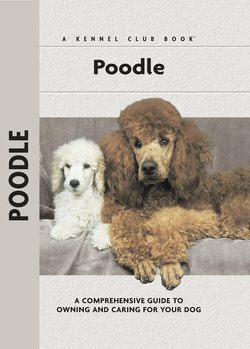Читать книгу Poodle - S. Meyer Clark - Страница 8
На сайте Литреса книга снята с продажи.
ORIGIN OF THE BREED
ОглавлениеIn the Middle Ages, from as far back as the 12th to the 15th century, Poodle-like dogs appeared in art and on carvings, coins and Roman tombs. This ancient breed has always displayed a unique style of coat, whether it was corded (hanging to the ground in long twists of hair) or curly and wiry (lending itself to hand-scissoring in a variety of patterned trims).
In modern times, three countries emerge as the original homes of the Poodle: Germany, Russia and France. All three countries presented their versions of the Poodle; each was designed for specific purposes. For example, the German Poodles were referred to as Pudel dogs.
Eng. Ch. Gondolette, bred by Miss H. C. Throwgood in 1924, was the daughter of two famous dogs of the time, Eng. Ch. Ambrette and Eng. Ch. Cadeau.
These dogs were heavy-boned and bred to retrieve fallen game, such as ducks, from the water—hence the name Pudel, which means “to splash in water.”
The Russian Poodle was taller and more refined than its German cousin, thus lending itself to the role of companion dog. French Poodles were adored by the fashion world because their curly, woolly coats were ideal for elaborate grooming and styling. Their loving devotion to their owners also earned them high ratings.
For centuries, the Poodle has been considered the height of fashion. Note that these Miniatures have bows on their topknots as well as around their wrists.
When the Miniature Poodle eventually emerged in all three countries, it proved ideal as a circus dog. Owing to its intelligence and willingness to please, the Miniature Poodle was easy to train, appealing to audiences and easy to manage as the troupes moved from town to town.
Poodles were so popular in Europe that the famous Spanish painter Francisco de Goya rendered them in the 1700s. In fact, King Louis XVI of France commissioned Goya to create a portrait of a Poodle beloved by his wife, Marie Antoinette. Even before that, Albrecht Durer, a German artist, portrayed Poodles in his 15th-century paintings.
Many breed historians purport that, as far back as the first century, the Poodle was created by blending the white Maltese dog and the Spanish dog known as the Spaniel. Certainly both of these breeds could have contributed their friendly personalities to the Poodle’s gene pool. Additionally, the Spaniel’s love for water and its retrieving traits may be responsible for the Poodle’s ability to retrieve fallen ducks from the water.
Regardless of their country of origin, Poodles have been and continue to be excellent retrievers. They love to carry things in their mouths and are easily trained to retrieve fallen game for hunters as well as toys and other objects for pet owners. In addition, their love of water and swimming makes them desirable as family companions in today’s world. Boat owners and beach-goers alike find their Poodles eager to accompany them for sport and fun. Many Poodles even love to walk in the rain.
Until the 16th century, Poodles were large dogs known as Standards. They needed to be large, strong dogs, capable of retrieving fallen game, because they were primarily hunters’ dogs. This work, however, created one serious problem. Since hunting back in the early times was for food rather than for sport, men in the Middle Ages needed a dog that would bring in game wherever it fell. However, when the game fell over the water, the heavily coated Poodle would often drown while attempting to retrieve the fallen bird. The Poodle’s thick coat would soak up so much water that the dog could not stay afloat due to the weight of the water.
Eng. Ch. Barbet Chita was counted among Mrs. Crimmins’ noted Miniature Poodles. Poodles bred under Mrs. Crimmins’ Barbet prefix were some of the best of the time.
In Vienna, 1929, the Poodle, more especially the white Miniature variety, was considered among the most fashionable of companion dogs.
Hunters solved this problem by cutting off all unnecessary hair on the dog. Hair on the feet, face, tail and hindquarters was not needed, so it was trimmed away. Hair over the chest and around the lung and kidney areas was left to protect the dog from the frigid waters. Thus was born the art of Poodle grooming, and this tradition remains mandatory for Poodles in the show ring today. The modern misconception that Poodle hairstyles make the dogs look overly feminine is rightly dispelled when one understands that cutting away the hair not needed for protection was necessary to make the dog more utilitarian.
Here are typical examples of British dogs of the 1930s produced by Phidgity Kennels.
During the 16th to 18th centuries, people began breeding smaller-sized Standard Poodles to create the Miniature Poodle. The Miniature became the ideal pet dog for the same reasons that he was used in circuses and stage shows: he was athletic, eager to please, attractive and affectionate.
No sooner had Miniature Poodles become popular with pet owners than breeders began developing an even smaller dog, the Petit Barbet or Toy Poodle. Originally they were called ‘Sleeve Poodles’ because they were so small that they could be carried around in the sleeves of ladies’ gowns. The ladies of France, for example, loved the Toy Poodle because, when groomed properly, it was particularly clean and attractive.
Mrs. L. W. Crouch’s Poodles, photographed in 1907 by T. Fall.
Poodles from the turn of the 20th century. Note their curly coats and smart topknots.
